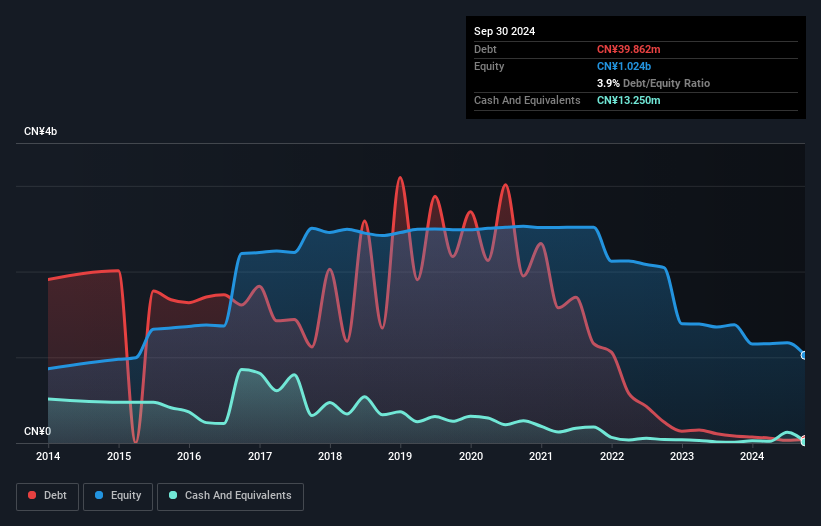Howard Marks put it nicely when he said that, rather than worrying about share price volatility, 'The possibility of permanent loss is the risk I worry about... and every practical investor I know worries about.' So it might be obvious that you need to consider debt, when you think about how risky any given stock is, because too much debt can sink a company. As with many other companies Jiangsu Wanlin Modern Logistics Co., Ltd. (SHSE:603117) makes use of debt. But should shareholders be worried about its use of debt?
When Is Debt Dangerous?
Debt is a tool to help businesses grow, but if a business is incapable of paying off its lenders, then it exists at their mercy. In the worst case scenario, a company can go bankrupt if it cannot pay its creditors. While that is not too common, we often do see indebted companies permanently diluting shareholders because lenders force them to raise capital at a distressed price. Of course, the upside of debt is that it often represents cheap capital, especially when it replaces dilution in a company with the ability to reinvest at high rates of return. When we think about a company's use of debt, we first look at cash and debt together.
What Is Jiangsu Wanlin Modern Logistics's Debt?
The image below, which you can click on for greater detail, shows that Jiangsu Wanlin Modern Logistics had debt of CN¥39.9m at the end of September 2024, a reduction from CN¥81.2m over a year. However, because it has a cash reserve of CN¥13.2m, its net debt is less, at about CN¥26.6m.

How Strong Is Jiangsu Wanlin Modern Logistics' Balance Sheet?
 We can see from the most recent balance sheet that Jiangsu Wanlin Modern Logistics had liabilities of CN¥325.3m falling due within a year, and liabilities of CN¥77.8m due beyond that. Offsetting this, it had CN¥13.2m in cash and CN¥164.0m in receivables that were due within 12 months. So its liabilities total CN¥225.9m more than the combination of its cash and short-term receivables.
We can see from the most recent balance sheet that Jiangsu Wanlin Modern Logistics had liabilities of CN¥325.3m falling due within a year, and liabilities of CN¥77.8m due beyond that. Offsetting this, it had CN¥13.2m in cash and CN¥164.0m in receivables that were due within 12 months. So its liabilities total CN¥225.9m more than the combination of its cash and short-term receivables.
Since publicly traded Jiangsu Wanlin Modern Logistics shares are worth a total of CN¥4.95b, it seems unlikely that this level of liabilities would be a major threat. However, we do think it is worth keeping an eye on its balance sheet strength, as it may change over time. Carrying virtually no net debt, Jiangsu Wanlin Modern Logistics has a very light debt load indeed. When analysing debt levels, the balance sheet is the obvious place to start. But you can't view debt in total isolation; since Jiangsu Wanlin Modern Logistics will need earnings to service that debt. So if you're keen to discover more about its earnings, it might be worth checking out this graph of its long term earnings trend.
In the last year Jiangsu Wanlin Modern Logistics had a loss before interest and tax, and actually shrunk its revenue by 29%, to CN¥299m. That makes us nervous, to say the least.
Caveat Emptor
Not only did Jiangsu Wanlin Modern Logistics's revenue slip over the last twelve months, but it also produced negative earnings before interest and tax (EBIT). To be specific the EBIT loss came in at CN¥17m. Considering that alongside the liabilities mentioned above does not give us much confidence that company should be using so much debt. So we think its balance sheet is a little strained, though not beyond repair. For example, we would not want to see a repeat of last year's loss of CN¥206m. So to be blunt we do think it is risky. There's no doubt that we learn most about debt from the balance sheet. However, not all investment risk resides within the balance sheet - far from it. Be aware that Jiangsu Wanlin Modern Logistics is showing 2 warning signs in our investment analysis , and 1 of those is a bit concerning...
Of course, if you're the type of investor who prefers buying stocks without the burden of debt, then don't hesitate to discover our exclusive list of net cash growth stocks, today.
Have feedback on this article? Concerned about the content? Get in touch with us directly. Alternatively, email editorial-team (at) simplywallst.com.
This article by Simply Wall St is general in nature. We provide commentary based on historical data and analyst forecasts only using an unbiased methodology and our articles are not intended to be financial advice. It does not constitute a recommendation to buy or sell any stock, and does not take account of your objectives, or your financial situation. We aim to bring you long-term focused analysis driven by fundamental data. Note that our analysis may not factor in the latest price-sensitive company announcements or qualitative material. Simply Wall St has no position in any stocks mentioned.
